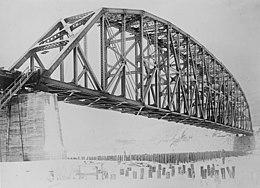Walter E. Angier
Walter Eugene Angier (born May 18, 1863 in Fitzwilliam , New Hampshire , † December 29, 1928 in Wheaton , Illinois ) was an American civil engineer . He mainly dealt with waterways and bridge construction . After graduating in 1887, he worked under Octave Chanute , George S. Morison and Ralph Modjeski , whose partner he became in 1910. Angier and Modjeski realized several large railway bridges by 1926 , including the Thebes Bridge (1905), the Oregon Trunk Rail Bridge (1912) and the Harahan Bridge (1916).
Life

Walter Eugene Angier was born on May 18, 1863 to Philip Doddrige and Sahra Arabella Angier (née Redd) in Fitzwilliam, New Hampshire. His grandfather, Abel Angier, was one of the first settlers in Fitzwilliam in south-east Cheshire County and ran a farm here. Walter E. Angier was the cousin of the poet Eugene Field . Walter's mother he dedicated his volume of poems Love Songs of Childhood (1894), which their son Walter Eugene named after him.
Walter E. Angier studied at New Hampshire College of Agriculture and the Mechanic Arts ( Bachelor of Science , 1885) and later at the Thayer School of Engineering at Dartmouth College , where he graduated in 1887 as a civil engineer (civil engineer) made. He gained his first experience in bridge building under Octave Chanute with the construction of the first Fort Madison Toll Bridge (1887) in Fort Madison . He then worked on the port expansion in Galveston and as a United States Assistant Engineer on surveys of the Rio Grande in New Mexico and Texas . From 1889 he worked under George S. Morison as an assistant engineer in the construction of the Frisco Bridge (1892), together with Ralph Modjeski (chief draftsman) and Alfred Noble ( liaison engineer ). In 1892 he became a bridge inspector with the Illinois Central Railroad and was later involved as an assistant engineer in the construction of some bridges for the railway company. In 1902 Walter E. Angier was given the post of liaison engineer at Noble & Modjeski for the construction of Thebes Bridge (1905) and in 1910 he entered into a partnership with Modjeski himself. As Modjeski & Angier they realized the Oregon Trunk Rail Bridge (1912), the Harahan Bridge (1916) and the Mears Memorial Bridge (1923). They also carried out a reinforcement of the Poughkeepsie Bridge in 1917 .
Walter E. Angier married Mary Powell in 1889, with whom he had three children, two sons and a daughter. His son Philip Powell Angier became a civil engineer like his father and was involved in the construction of the Mid-Hudson Bridge (1930) in New York under Ralph Modjeski. Walter E. Angier suffered a stroke in 1926 and was forced to quit his job. He died on December 29, 1928 in his home in Wheaton , Illinois.
See also
Web links
- Walter Eugene Angier, 1863-1928. Minerva Systems, Dr. Cora Angier Sowa, accessed February 10, 2018.
- Photos from the construction of the Frisco Bridge, donated by Estelle Angier. Digital Archive of the Memphis Public Library, accessed February 10, 2018.
Individual evidence
- ^ Genealogy of the Angier Family. Minerva Systems, Dr. Cora Angier Sowa, accessed February 10, 2018.
- ↑ a b c Memoir of Walter Eugene Angier. American Society of Civil Engineers, from Minerva Systems (Dr. Cora Angier Sowa), accessed February 10, 2018.
- ^ Alfred Noble, Ralph Modjeski: The Thebes Bridge. A report to the president and directors of the Southern Illinois & Missouri bridge company. WF Hall Printing Company, Chicago 1907, p. 11.
- ↑ MB Case: Substructure of the New “Harahan” Bridge at Memphis. In: Railway Age Gazette. Vol. 58, No. 17, 1915, pp. 877-881, here p. 881.
- ^ Poughkeepsie Bridge Again Being Reinforced - New Floor System. In: Engineering Record, Building Record and Sanitary Engineer. Vol. 75, No. 7, 1917, p. 253.
- ^ Engineers in the Family, Part II: Philip Powell Angier, civil engineer. Minerva Systems, Dr. Cora Angier Sowa, accessed February 10, 2018.
| personal data | |
|---|---|
| SURNAME | Angier, Walter E. |
| ALTERNATIVE NAMES | Angier, Walter Eugene |
| BRIEF DESCRIPTION | American civil engineer |
| DATE OF BIRTH | May 18, 1863 |
| PLACE OF BIRTH | Fitzwilliam , New Hampshire |
| DATE OF DEATH | December 29, 1928 |
| Place of death | Wheaton , Illinois |
